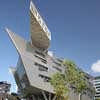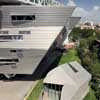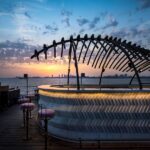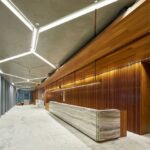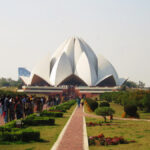GMS Grande Palladium, Indian Building Project, Photo, News, Design, Image
GMS Grande Palladium Mumbai, India Restaurant
GMS Grande Palladium Mumbai – design by Malik Architecture
9 Aug 2010
GMS Grande Palladium
Category: Office (inc mixed use)
Location: Mumbai, India
Architect: MALIK ARCHITECTURE, Mumbai, India
WAF Entry: 2010
Award: World Architecture Festival 2010 – Shortlisted
GMS Grande Palladium
The uniqueness of this project is that it operates on multiple levels. On one hand it uses technology and intelligent design to improve the working environment of its inhabitants, while working inclusively in an urban context.
On the other hand, it is a critical commentary on some of the antiquated notions that have plagued contemporary commercial design in the subcontinent. The eschewment of ornamentation, the treatment of structure as skin, the repudiation of self-aggrandizing atriums, the moulding of building volumes to perform many functions simultaneously, the treatment of landscape as an integral part of development and an exploration of its varying moods, the focus on sustainability, the holistic approach to design and execution are a direct result of a critical analysis of the exigent and often superficial buildings proliferating in the subcontinent.
Commercial and corporate architecture in Mumbai has evolved a generic idiom and nowhere is this more apparent than at the Bandra Kurla Complex (BKC), where a myriad of glass monoliths exist side by side; one indistinguishable from the other.
The site for the GMS Grande Palladium, located at Kalina, is but a stones throw from Bandra Kurla Complex. The street interface for almost all existing buildings at BKC is a three level podium. This provides a definiteive barrier between the street and the building. A heavy, almost impenetrable profile is created which presents almost no visual and physical connection between the street and the building.
It was imperative that we make an informed departure from the existing architecture surrounding our site, and, in the absence of any valid programmatic density within the project brief itself, we harvested site, climatic and urban constrains as moulding vectors for our concept.
Four levels of leasable commercial space are bound by a volume shaped by the diurnal cycles of the sun, an even distribution of floor area and by the desire to visually lengthen the proportion of the structure.
We hoisted the building 8.0m above the ground thus liberating the street level to be inhabitated by trees, water and judiciously scaled lobbies and a common café, thus eliminating the presence of massive built up form at the street level. This represents an inversion of the Bandra Kurla typology by creating a solution that is more inclusive to street communication.
With GMS Grande Palladium, we have made an attempt, through consistent data mining of various conditions, to imbue what has been a hitherto sterile, symbol driven genre of Architecture, with logic and meaningful content.
The transition from the street to inside the property is experienced seamlessly, one drives through a gate, up a ramp to access the podium level. The ramp is flanked on one side by a landscaped garden, the slopes of which transition from the entrance stilt level to the upper podium level. In a city like Mumbai where green areas are diminishing everyday, this garden provides an oasis of relief from the hardscape of the surrounding areas.
The clubhouse emerges from this landscape as a sculptural element. In most other buildings the Clubhouse is provided on the uppermost levels, but in view of better access and usability, we chose to place the clubhouse on the stilt level with a double height gym space.
The 8.0M high podium is designed to address functional issues as well as theoretical inconsistencies that we have observed in the design of commercial and corporate properties in the vicinity. Four months of heavy rains mean that a covered drop-off point is mandatory. The suspended building volume negates the need for extraneous canopies, and the ubiquitous atrium has been replaced with functionally scaled lobbies, that use space efficiently and visually include the landscaped podium and allow the eye to roam unfettered to the grass berm beyond.
Water has been expressed in two ways; a shallow water sheet explores the reflective and depth inducing properties of water, while adjacent to it, raked and textured stone surfaces generate rippling water surfaces; a gesture that not only explores its auditory properties, but also geometrically links it to the building structure. A common café is skinned with canted glass walls and an outdoor dining area allows inhabitants to sit amidst the trees on the podium.
The superstructure is composed entirely of steel with a 16.0m wide span central column grid providing flexible workspace, while deflected structural shear skins transmit cantilever loads to the ground. The structural skins are expressed internally by recessing the internal membranes between the structural members.
The four typical floors are designed to be leased out. Each floor has been divided into two wings which may be leased out independently with a common lobby space opening into independent reception areas. The two wings may be combined if desired to create a bigger office space by removing the dividing wall between the wings. The structure also facilitates higher floor heights with the false ceiling dropping down in the cabins and lobby to accommodate services.
The fragmented roof office of the client visually disconnects itself from the typical floors, the only tangible link being a section of the structural skin turning over to generate the faceted roof and glass wall membranes of the upper two levels.
This was the only part of the design brief where the customized program was known. The office was placed on the North end occupying two internally connected office floors. A double height cut out in the floor plate visually connects the two levels together. The sense of space and openness in this office space alludes to the old buildings of South Mumbai with higher floor heights and double height spaces. A projected roof on the East and West facade facilitates large floor to ceiling windows which flood the interior with daylight.
The client and his son occupy suites at the two extremities of a cantilevered tube that punctures the upper level and projects into space. The tube is oriented facing North and provides sweeping views of the North.
GMS Grande Palladium Mumbai images / information from FD
Location: Mumbai, India
Architecture in India
Indian Architecture Designs – chronological list
New Delhi Architecture Walking Tours by e-architect
Indian Architect : architecture practice contact details
Indian Architecture – Selection
RMJM
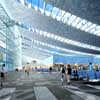
image from architects
Kolkata Airport
Nariman Point, Mumbai
Chapman Taylor
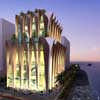
image from architects
Nariman Point
Morphogenesis
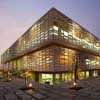
image from architects
Pearl Academy of Fashion Jaipur
Comments / photos for the GMS Grande Palladium Mumbai Architecture page welcome

